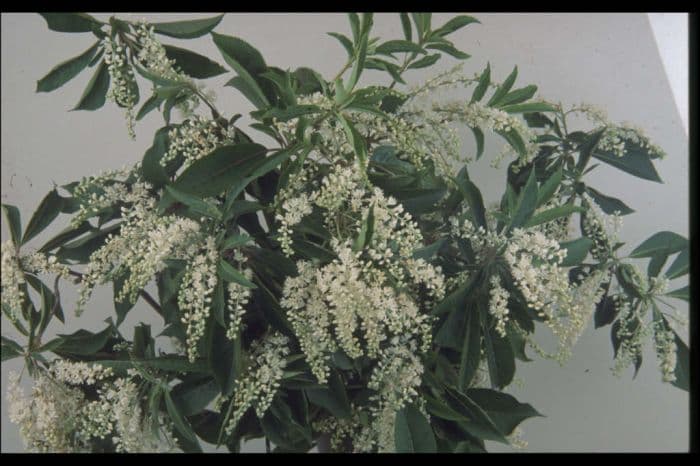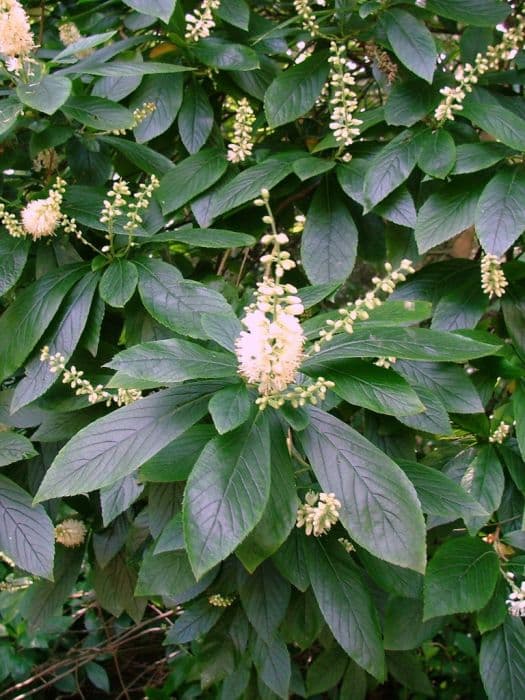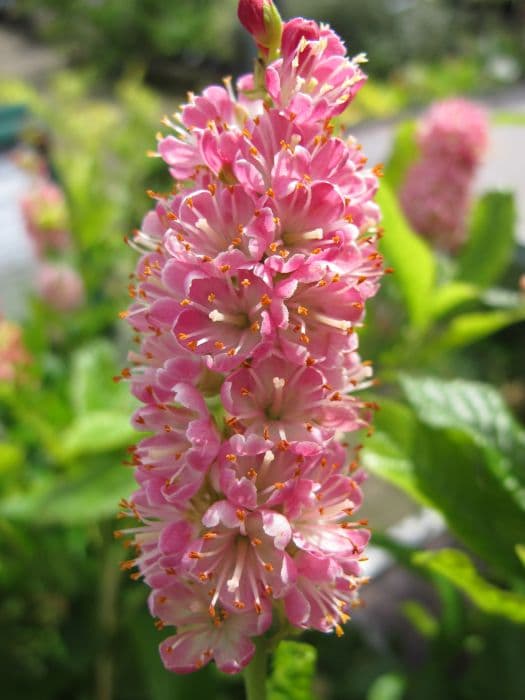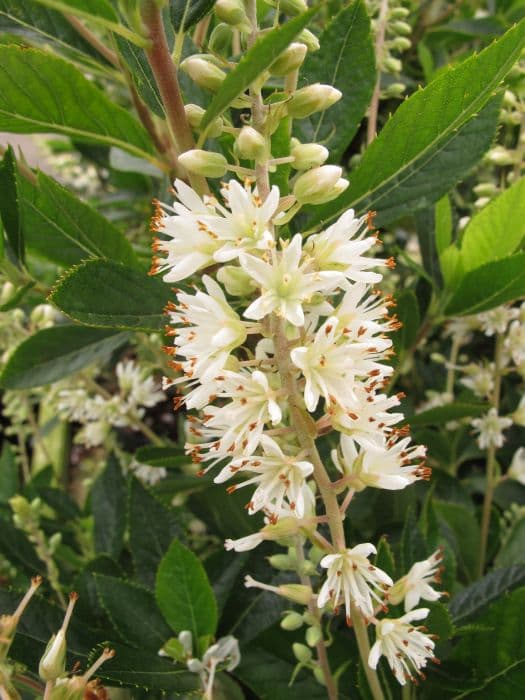Japanese Clethra Clethra barbinervis

ABOUT
The plant commonly known as Japanese sweetshrub is an attractive deciduous shrub that stands out in gardens and natural landscapes. This plant is characterized by its glossy, bright green leaves which take on a pleasant, yellow hue come fall, ushering in a touch of autumn color. The leaves are ovate to oblong in shape, sporting a finely serrated margin that adds a delicate texture to the foliage. One of the most striking features of the Japanese sweetshrub is its flowers. These blooms are small and fragrant, arranged in erect or slightly drooping, bottlebrush-like spikes. They are typically white, though they can have a hint of pink, and they exude a sweet, spicy scent that can perfume the air, particularly in the evening. This pleasant aroma is a draw for pollinators and can add an olfactory highlight to any garden space during its flowering season. Following the flowering period, the Japanese sweetshrub produces dry, brown capsules that contain the seeds. These capsules add further interest to the shrub through late summer and into fall. The bark of the Japanese sweetshrub is another point of interest; it has an exfoliating quality, peeling away in strips to reveal a multi-textured surface of gray and brown, providing year-round visual appeal even after the leaves have fallen. Overall, the Japanese sweetshrub presents a well-rounded, sensorial experience with visual, aromatic, and tactile qualities that can enhance diverse planting schemes.
About this plant
 Names
NamesFamily
Clethraceae
Synonyms
Japanese Clethra, Japanese Sweetshrub, Peppercorn Tree
Common names
Clethra barbinervis.
 Toxicity
ToxicityTo humans
Japanese clethra is not typically known to be toxic to humans. There is little to no information suggesting that Japanese clethra poses any significant risk if ingested or handled. However, as with any plant material, individual allergies or sensitivities could potentially cause mild irritation or discomfort.
To pets
Japanese clethra is not widely recognized for being toxic to pets. There does not seem to be any substantial evidence that suggests the ingestion of Japanese clethra poses a serious threat to the health of domestic animals such as cats and dogs. Nevertheless, pet owners should always exercise caution and prevent pets from eating plants, as individual animals might have unique sensitivities.
 Characteristics
CharacteristicsLife cycle
Perennials
Foliage type
Deciduous
Color of leaves
Green
Flower color
White
Height
10-15 feet (3-4.5 meters)
Spread
5-8 feet (1.5-2.4 meters)
Plant type
Shrub
Hardiness zones
5
Native area
Japan
Benefits
 General Benefits
General Benefits- Attracts Wildlife: Clethra barbinervis, also known as Japanese sweetshrub, is known to attract bees, butterflies, and other beneficial pollinators due to its fragrant flowers.
- Aesthetic Appeal: The Japanese sweetshrub has attractive, glossy green leaves and panicles of white or pink flowers that add beauty to gardens and landscapes.
- Seasonal Interest: It provides seasonal interest with flowers in summer and vibrant yellow to golden-brown foliage in the fall.
- Erosion Control: The shrub has fibrous root systems that can help stabilize soil and prevent erosion on slopes or banks.
- Shade Tolerance: This plant can thrive in partial shade, making it suitable for understory planting and shaded garden areas.
- Low Maintenance: Once established, the Japanese sweetshrub is low maintenance, requiring minimal care and watering.
- Wildlife Shelter: The dense foliage offers shelter and nesting sites for birds and small wildlife.
- Adaptable to Soil Types: It is adaptable to various soil types, though it prefers moist, well-drained soils.
 Medical Properties
Medical PropertiesThis plant is not used for medical purposes.
 Air-purifying Qualities
Air-purifying QualitiesThis plant is not specifically known for air purifying qualities.
 Other Uses
Other Uses- Woodworking: The wood of the Japanese clethra is dense and can be used in fine woodworking projects, such as crafting small wooden items, including tool handles and intricate carvings.
- Garden Design: With its attractive foliage and fragrant flowers, the Japanese clethra is often used as a focal point in shade gardens or woodland settings.
- Wildlife Habitat: The dense foliage provides shelter for small animals and birds, while its flowers attract pollinators such as bees and butterflies.
- Culinary Uses: Although not commonly used, the flowers of the Japanese clethra may be incorporated into some traditional Japanese sweet dishes for their fragrance.
- Perfumery: The scent of the Japanese clethra flowers can be used in the making of natural perfumes and scented oils.
- Art and Craft: The dried flowers and seed pods can be used in creating botanical arts, such as pressed flower arrangements and decorative wreaths.
- Dye Production: The bark of the Japanese clethra can be used as a source of tannins for dyeing fabrics a light brown or tan color.
- Soil Improvement: The plant can help in soil conservation by stabilizing soil and preventing erosion in sloped gardens.
- Water Features: Japanese clethra is suitable for planting near ponds or streams, as it appreciates moist soil conditions and can enhance the aesthetic of water features.
- Educational Tool: The plant can be used in educational settings, such as botanical gardens, to teach about plant biodiversity and ecology in Japan.
Interesting Facts
 Feng Shui
Feng ShuiThe Japanese Clethra is not used in Feng Shui practice.
 Zodiac Sign Compitability
Zodiac Sign CompitabilityThe Japanese Clethra is not used in astrology practice.
 Plant Symbolism
Plant Symbolism- Fragrance: Clethra barbinervis, commonly known as Japanese clethra, is known for its sweetly fragrant flowers, symbolizing the spreading of good vibes and positive energies.
- Resilience: This plant's ability to thrive in a variety of conditions signifies adaptability and resilience in the face of changing circumstances.
- Summer Blossoming: Since Japanese clethra blooms in the summer, it is often associated with the warmth and vitality of the summer season, representing growth and abundance.
- Purification: The plant is sometimes thought to represent purification or cleanliness, possibly owing to the refreshing nature of its fragrance.
 Water
WaterThe Japanese clethra prefers consistently moist soil, so it should be watered regularly, allowing the top inch of soil to dry out slightly between waterings. During the growing season in spring and summer, this may translate to watering once every week with approximately 1 to 1.5 gallons, depending on the size of the plant and environmental conditions. In the fall and winter, when the plant is not actively growing, reduce watering frequency to once every two to three weeks with slightly less water, ensuring the soil does not become waterlogged.
 Light
LightJapanese clethra thrives in partial shade to full sun. It performs best in a location where it receives morning sunlight and is protected from the intense heat of the afternoon sun. An ideal spot would be under the light shade of taller trees where it can benefit from dappled sunlight throughout the day.
 Temperature
TemperatureJapanese clethra is hardy and can withstand temperatures ranging from 20°F to 85°F. The plant thrives in temperatures between 60°F and 75°F. It's essential to protect it from extreme cold by providing mulch or shelter when temperatures plunge below 20°F.
 Pruning
PruningPrune Japanese clethra to maintain its shape and remove any dead or damaged wood. The best time for pruning is late winter or early spring before new growth begins. Pruning every year or two is often enough to keep the plant healthy and well-structured.
 Cleaning
CleaningAs needed
 Soil
SoilJapanese Clethra prefers moist, well-drained, acidic soil with a pH between 5.0 and 6.0. An optimal soil mix would include 50% peat, 30% pine bark, and 20% perlite to ensure good drainage and aeration while retaining adequate moisture.
 Repotting
RepottingJapanese Clethra does not require frequent repotting; it typically needs repotting every 3-4 years. It is best to repot in the spring before new growth begins.
 Humidity & Misting
Humidity & MistingJapanese Clethra thrives in moderate to high humidity levels. Maintaining a humidity level of around 50-60% is ideal for this plant.
 Suitable locations
Suitable locationsIndoor
Place in bright, indirect light with moist soil.
Outdoor
Plant in part-shade, moist soil, and shelter from strong winds.
Hardiness zone
5-8 USDA
 Life cycle
Life cycleClethra barbinervis, commonly known as Japanese Clethra, begins its life cycle when the seeds germinate in moist, well-drained soil in spring. Seedlings emerge and develop into juvenile plants with characteristic toothed foliage and a gradually forming central stem. As it matures, the plant enters the vegetative stage, producing distinctive oval-shaped leaves and begins to establish a strong root system. The reproductive stage follows, typically in midsummer, when the Japanese Clethra showcases dense, fragrant, white flower spikes that attract pollinators. After pollination, it produces capsules containing the seeds that, upon maturity, disperse to begin a new generation. During winter, the plant enters dormancy, conserving energy and resources until the next spring when the cycle can recommence.
 Propogation
PropogationPropogation time
Summer to early autumn
The Japanese Clethra (Clethra barbinervis) is most commonly propagated using semi-hardwood cuttings. To achieve successful propagation, cuttings should be taken in the late summer. Choose a healthy branch and make a cutting about 4 to 6 inches (10 to 15 centimeters) long, with several leaves attached. The cut end should be dipped in rooting hormone powder to increase the chances of root development. Then, plant the cutting in a pot filled with a mixture of peat and perlite or a similar rooting medium, ensuring that the lower leaf nodes are covered by the substrate. The cutting should be kept moist and in a warm place with indirect sunlight until roots have developed, which typically takes several weeks. Once rooted, the new Clethra plant can be transplanted to a more permanent location.


